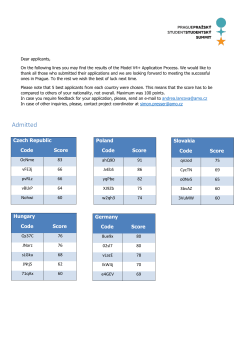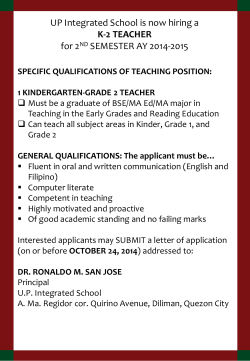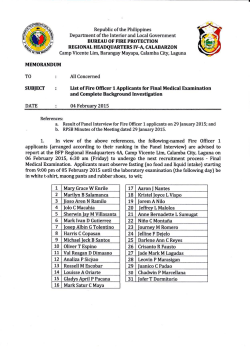
Concept Note
Concept Note PROGRAMMA / LINEA DI FINANZIAMENTO: EUROPEAN COMMISSION DIRECTORATE-GENERAL MIGRATION AND HOME AFFAIRS PROGRAMMA: HOME/2014/AMIF/AG/ASYL TEMATICA: ASYLUM, MIGRATION AND INTEGRATION FUND (AMIF) 2014-2020 TOPIC 1: CALL FOR PROPOSALS FOR ASYLUM ACTION GRANTS (ASYL CFP) Background & Justification The data presented by Eurostat "Population and social conditions" (3/2014) report of 435,000 asylum seekers in Europe in 2013 (with an increase of over 100,000 compared to 2012 and further growth recorded in 2014), of them 1 of 4 is under 18 years (25.6% in the amount of about 111,000 UMAS newly entered in the EU), and 50.4% is aged 18-34 years; higher increases from populations fleeing conflict contexts, mainly from Mediterranean border (Syrians, Afghans, Eritreans, Somalis), but also from the eastern border (particularly Russians, Serbs and Kosovars). Focusing just on applications from citizens of non-member countries, there was a gradual increase in the number of asylum applications within the EU-27 and later the EU-28 through to 2012, after which the rate of change quickened considerably as the number of asylum seekers rose to 435 thousand in 2013 and 626 thousand in 2014; this was the highest number of asylum applicants within the EU since the peak in 1992. This latest figures for 2014 marked an increase of almost 191 thousand applicants in relation to the year before, in part due to a considerably higher number of applicants from Syria, Eritrea, Kosovo (UNSCR 1244/99), Afghanistan and Ukraine and to a lesser extent from Iraq, Serbia, Nigeria and the Gambia Asylum applicants from Syria rose to 123 thousand in the EU-28 in 2014, which equated to 20 % of the total from all non-member countries. Afghani citizens accounted for 7 % of the total, while Kosovans and Eritrean citizens accounted for 6 % and Serbians for 5 %. Among the 30 main groups of citizenship of asylum applicants in the EU-28 in 2014, by far the largest relative increase compared to 2013 was recorded for individuals from Ukraine. There were also considerable increases in relative terms in the number of applicants from several African countries (The Gambia, Eritrea, Senegal, Mali, Sudan and Nigeria), two Middle Eastern countries (Syria and Iraq), as well as Western Balkan countries (Kosovo, Albania, and Bosnia and Herzegovina), and large increases of applicants from unknown origins and Stateless applicants. The largest relative fall in applicants, among these 30 countries, was recorded for Russia, as the number of Russian asylum seekers more than halved between 2013 and 2014. A number of factors play a role in determining where an asylum seeker will lodge his / her application. These include historical ties between countries of origin and destination (former colMod.34 Ed.2 Rev.0 Pagina 1 di 7 Concept Note onies for instance), a certain knowledge of the language used in the host country, the presence of established ethnic communities, and the economic situation of the destination country. These pull factors largely overlap with the drivers of other non-asylum migration flows. However, other factors such as the perceived likelihood that the destination country will grant a protection status or the benefits connected to a protection status are specific to asylum seekers. Syrians accounted for the highest number of applicants in 11 of the 28 EU Member States, including 41 thousand applicants in Germany (the highest number of applicants from a single country to one of the EU Member States in 2014) and 31 thousand applicants in Sweden. The number of asylum applicants in 2014 more than doubled compared with 2013 in Italy (an increase of 143 %), Hungary (126 %) and Denmark (105 %), while it has halved in Croatia (-58 %) and Poland (-47 %). Nearly four in every five (79 %) asylum seekers in the EU-28 in 2014 were aged less than 35 (see Table 3); those aged 18–34 accounted for slightly more than half (54 %) of the total number of applicants, while minors aged less than 18 accounted for one quarter (25 %). This age distribution for asylum applicants was common in the vast majority of the EU Member States, with the largest share of applicants usually being those aged 18–34. There was one exception to this pattern: Poland reported a higher proportion of asylum applicants aged less than 18. The distribution of asylum applicants by sex shows that men were more likely than women to seek asylum. Across the EU-28, the gender distribution was most balanced for asylum applicants aged less than 14, where boys accounted for 53 % of the total number of applications in 2014. There was a greater degree of gender inequality for asylum applicants aged 14–17 or 18– 34, where around three quarters of applicants were male. Female applicants outnumbered male applicants for asylum seekers aged 65 and over, although this group was relatively small, accounting for just 0.8 % of the total number of applications in 2014. The gender difference was even more apparent when considering unaccompanied minors, as 84 % of asylum applicants in the EU-28 in 2013 that were unaccompanied minors were male. UNHCR has recently conducted assessments in several EU countries in which refugee men, women, boys and girls have participated. These assessments have revealed what refugees perceive as key obstacles to integration. These include: • difficulties due to lack of knowledge of local languages and differing cultures; • discrimination and unreceptive attitudes towards foreigners; • lack of understanding within host societies of the specific situation of refugees; • psychological impact of protracted inactivity during asylum procedures; • limited access to rights for persons with subsidiary protection. Project Proposal EUROPEAN COMMISSION DIRECTORATE-GENERAL MIGRATION AND HOME AFFAIRS 2015 Field-specific priority: Mod.34 Ed.2 Rev.0 Pagina 2 di 7 Concept Note Project applications under the present Call for Proposals will aim at identifying, developing and promoting good practices pertaining to the following priorities: 1) identification of special needs of vulnerable asylum seekers related to the asylum procedures and the reception conditions; 2) provision of legal and procedural information free of charge; 3) integration of persons benefiting from international protection. The expected results are the development of good practices and exchange of information in the above mentioned fields. To meet the priorities mentioned above, projects should achieve one or more of the following outcomes (non-exhaustive list): 1) Under the priority " Identification of special needs of vulnerable asylum seekers , related to the asylum procedures and the reception conditions": Exchange of information and development of good practices between national asylum authorities, between them and other stakeholders (such as non-governmental organisations and international organisations) on the identification of special procedural and reception needs of asylum seekers. This can include actions related to the development of common or national indicators and guidelines on this issue for asylum seekers with special needs in general or for a more specific group within asylum seekers with special needs. 2) Under the priority "Provision of legal and procedural information free of charge" in 1st instance procedure (Article 19 of the revised Asylum Procedures Directive ): Exchange of information and development of good practices between national asylum authorities, between them and other stakeholders (such as non-governmental organisations and international organisations) on the institutional and procedural framework applicable for the provision of legal and procedural information free of charge as well as the content of such information. Analysis of the impact of the provision of legal and procedural information on the overall quality of the decision making procedure, including trends in the number of appeals. 3) Under the priority "Integration of persons benefiting from international protection": Exchange of information and development of good practices between national authorities, between them and other stakeholders (such as local authorities, nongovernmental organisations and international organisations) and between the latter on issues related to new approaches on integration of persons benefiting from international protection. This would cover one or several of the different aspects of the integration process adapted to the needs of the persons benefiting from international protection (e.g. cultural and language courses, preparation measures to the access to the labour market, recognition of professional qualifications, training of staff dealing with persons benefiting from international protection, etc.). Mod.34 Ed.2 Rev.0 Pagina 3 di 7 Concept Note Project’s Specific Objectives: Exchange of information and development of good practices between national authorities, between them and other stakeholders on issues related to new approaches on integration of persons benefiting from international protection. Co-applicant: Potential country partners categories: - Central Authority/local - NGO (service provider) - University Italia: - CIR - Rete dei Comuni solidali - Comune di Milano (Assessore Majorino) - National Commission for Asylum ? - National Association Italian Municipalities ANCI? Potential European partners: Sweden Municipality of Sigtuna Migration Sverter - Swedish Migration Agency Netherland Beyond Borders National Dutch refugee council ? Bulgaria Nadia Fundation Unhcr BG EMN European Migration Network Belgium ??? Caritas? Municipality National EMN NCP European Migration Network Germany ??? Caritas? Municipality National EMN European Migration Network European Network ENGI European Network Guardianship ELISAN ESAN Mod.34 Ed.2 Rev.0 Pagina 4 di 7 Concept Note - EUROCITY We intend to consider best-practices implemented in Europe, on issues related to integration considering different items: 1. - Reception and integration phases 2. - Mainstreaming 3. - Naturalization 4. - Housing 5. – Employment – financial support 6. - Adult and child education 7. - Health 8. - Public relief and social security 9. - Language learning and cultural orientation 10. - Building bridges and fostering participation 11. - Family unity and reunification 12. - Funding for integration 13. - Mainstream services can meet the needs of a diverse population 14. - Technical resources dedicated to services 15. – Psychological support (presence of ethno-psychiatrist, Posttraumatic Stress Disorder expert ecc). The planned activities are therefore: PHASE I (months 1st – 12th): The WS1 Preliminary research will be aimed at gaining a deep knowledge of the phenomenon through literature analysis, field research (using interviews and focus groups), collection of persons benefiting from international protection life stories, analysis of good practices, in particular new approaches on integration of persons benefiting from international protection . 1. Desk analysis (law, national and European procedure, data comparison, projects and models), 2. Building of a benchmarking system, for the monitoring and the evaluation of integration process and indicators (social, linguistic, professional integration); - Definition of Areas to investigate (thematic & geographic) - Definition of Best practice for the Integration of persons benefiting from international protection. - Definition of a “Conceptual framework for the measurement of the path Integration”, starting from basic protection, up to citizenship and democratic participation. - Definition of social research methodology. 3. Field research (interview to migration association, single people and families, Institutional projects..) Mod.34 Ed.2 Rev.0 Pagina 5 di 7 Concept Note PHASE II (months 6th – 18th): The second phase WS2 Exchange aims to collect and systematize learning, suggestions and surveys carried out during the former phase in order to put them into Intellectual Outputs, in particular: 1. Identification of the first 20 best national practices implemented by National and Local Authorities. 2. International Call for civil society organization (Migrant associations, single person benefitting from international protection,… ) aimed at collecting of national and local best practices (through video, storytelling, ..). Identification of the first 20 best national practices from CSo and International Organisations. 3. National and international peer review meetings discussed during online meetings for comments, clarifications, integrations and suggestions to the other partners. 4. National round tables and seminars 5. International Platform with monthly online palimpsest for exchange and analysis of methodology and best practices: it will represent a shared arena of discussion for the partners and other relevant stakeholders. PHASE III (months 18th - 24th): The third stage WS3 Innovation is aimed at spreading innovative best practices, strengthening the network systems among local services (provided by public and private actors engaged in care, job and social inclusion of UMs), through the organization and the running of Multiplier Events, in the form of workshops and public Conferences on the project’s topic. Area 1. First international TED spreading ideas Conference on social Issues. Identification of the 10 main goals concerning Integration and Definition of an International strategic Planning. 2. Elaboration of guideline, video and handbook on selected Best practices. The requested amount of EU grant should not exceed EUR 750.000 and not be less than EUR 300.000. The EU co-financing rate requested cannot be higher than 90% of the total eligible costs of the action. In principle applications should target an estimated duration of 18 to 24 months. PARTNERSHIP’S FRAMEWORK Only non-profit entities established in an EU Member State participating in the AMIF or International Organisations14 are eligible for funding. This call will fund only transnational projects designed, submitted and implemented by a partnership of at least three (3) eligible distinct organizations established in at least three (3) EU Member States (i.e. the Coordinator, who will submit the application on behalf of the Partnership, established in one EU Member State + at least two (2) other distinct legal entities established in two (2) other EU Member States). All members of the partnership shall be actively involved in the implementation of the Mod.34 Ed.2 Rev.0 Pagina 6 di 7 Concept Note project. Activities implemented in non-EU Member States are not eligible under this call and the related costs will not be co-financed. ELEGIBILITY CRITERIA Each partner organization must fill-in and sign a Mandate letter to the main applicant. Applications must be sent no later than the deadline for submitting applications referred to in section 3. Applications must be submitted in writing using the Application Form provided (including all parts of the Application Package) and the PRIAMOS electronic submission system. Applications must be drafted in one of the EU official languages. DEADLINE Project submission: May, 20th 2015, 12.00 p.m. TIMETABLE Stages Date and time or indicative period a) Publication of the call for proposals 05/03/2015 b) Deadline for submitting applications 20/05/2015 – 12:00 CET (noon) c) Evaluation period May-September 2015 d) Information to Applicants September 2015 e) Signature of Grant Agreement(s) Autumn 2015 f) Starting date of implementation of the actions Upon the signature of the Grant Agreement Mod.34 Ed.2 Rev.0 Pagina 7 di 7
© Copyright 2025









